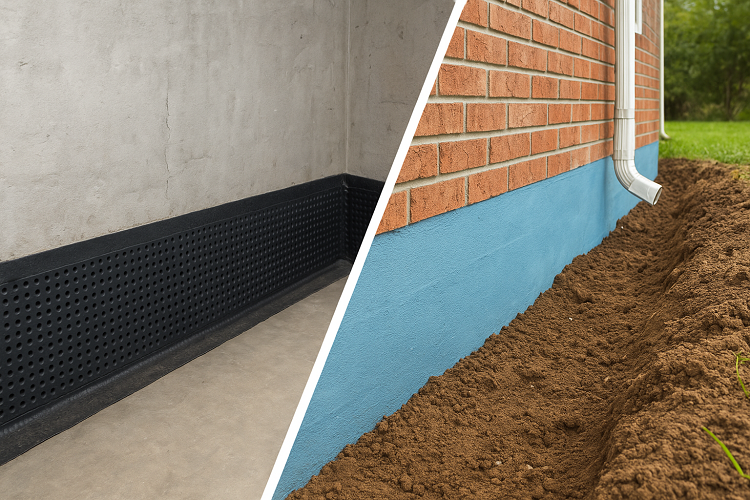
Water has a way of finding weaknesses; it can be tiny cracks, poorly sealed windows, or gaps in the roof. And when it does, it can damage not only your property but also your health. This is where waterproofing contractors in Dubai, like White Metal, step in to protect what matters most: your home, office, and peace of mind.
Let’s start by spotting the warning signs, and then we’ll break down the two main approaches: interior waterproofing and exterior waterproofing.
Signs You Need Waterproofing
- Damp or musty odors – A smell that lingers in certain rooms is often the first sign of hidden moisture.
- Peeling or bubbling paint – Moisture trapped behind walls pushes paint away from the surface.
- Water stains – Yellow or brown marks on walls or ceilings usually indicate a leak.
- Mold or mildew – Black or green patches can harm your health.
- Cracks in walls or floors – These small gaps are like open doors for water.
- Frequent leaks after rain – Regular wet patches are a clear sign your property’s protection is failing.
- Efflorescence – White, powdery residue on walls signals water penetration through masonry.
Understanding Interior Waterproofing
Interior waterproofing is all about managing water that has already entered your property. Instead of blocking water from the outside, it prevents it from spreading and causing damage indoors. It’s often used for basements, bathrooms, and any space that’s already exposed to moisture.
Processes In Interior Waterproofing
•Sealants & coatings – Applying waterproof paints or liquid membranes to stop water seepage.
•Interior drainage systems – Installing French drains or sump pumps to collect and redirect water.
•Vapor barriers – Using thick plastic sheets to block moisture from reaching living spaces.
•Crack repairs – Filling visible wall or floor cracks with special waterproof materials.
Pros Of Interior Waterproofing
•Cost-effective – Usually cheaper than exterior waterproofing.
•Less disruptive – No digging or major construction required.
•Quick installation – Many projects can be completed in a day or two.
Cons Of Interior Waterproofing
•Doesn’t stop water at the source – Manages the problem after it’s inside.
•Ongoing maintenance – Sealants and drainage systems may need upkeep.
•Not ideal for severe leaks – For major foundation leaks, it may not be enough.
Understanding Exterior Waterproofing
Exterior waterproofing is a preventive shield that stops water before it even touches your home’s structural walls. It’s more comprehensive but also more labor-intensive. This method is especially important in the UAE, where heavy rains can saturate the ground and push water against your foundation.
Processes In Exterior Waterproofing
•Excavation – Digging around the building to expose foundation walls.
•Waterproof membrane application – Applying thick, rubberized coatings for full moisture resistance.
•Drainage systems – Installing perforated pipes and drainage boards to carry water away.
•Backfilling – Refilling the excavated area with proper drainage materials.
Pros Of Exterior Waterproofing
•Stops water at the source – Offers long-term protection.
•Preserves structural integrity – Prevents cracks, leaks, and wall weakening.
•Prevents mold growth – Keeps moisture out of indoor spaces entirely.
Cons Of Exterior Waterproofing
•Higher cost – Requires more labor and materials.
•Disruption to landscaping – Digging may disturb gardens, pavements, or driveways.
•Weather-dependent – Heavy rains or extreme heat can delay work.
Factors To Consider When Choosing Interior And Exterior Waterproofing
Choosing between interior and exterior waterproofing isn’t just about cost; it’s about what’s best for your property in the long run. At White Metal, we always guide our clients through these key considerations before recommending a solution:
1. Severity of the problem: If you’re just seeing a bit of dampness or small leaks, interior waterproofing can usually sort things out without much hassle. But if water is really getting in or your foundation has serious damage, exterior waterproofing is the stronger, long-term fix that will keep the problem from coming back.
2. Budget and timeframe: Interior waterproofing is usually lighter on the wallet and can be done pretty quickly, perfect if you just want a fast, effective solution to moisture problems. Exterior waterproofing, however, costs more and takes longer, but it’s an investment that gives your home lasting protection against water damage.
3. Age and condition of the building: Older homes often have weaker foundations or visible cracks that need exterior sealing to stop further damage. If your place is fairly new, interior waterproofing is a great way to tackle minor moisture early and prevent it from turning into a bigger headache later.
4. Climate and location in the UAE: If you live somewhere with heavy rains or high groundwater levels, exterior waterproofing is the safest bet because it stops water from entering in the first place. However, if your property is in a drier area with limited water exposure, interior waterproofing may be all you need to keep things under control.
5. Accessibility and disruption: Interior waterproofing is less messy; it doesn’t involve digging, so your garden, driveway, or outdoor spaces stay untouched. Exterior waterproofing often means excavation work, which can temporarily disturb your landscaping or outdoor setup.
6. Long-term plans for the property: If you’re planning to stay in your home for years or treat it as a big investment, exterior waterproofing is worth considering for its long-term benefits. But if you need a quick and affordable fix before selling or renting, interior waterproofing can do the job without the extra time and expense.
Your home or office is one of your biggest investments. Protecting it with the right waterproofing method, done by expert waterproofing contractors in Dubai, is essential.


